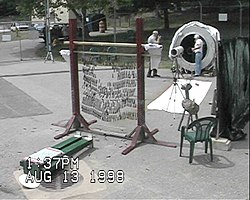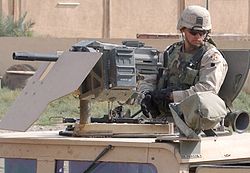Electrothermal-chemical (ETC) technology is an attempt to increase accuracy and muzzle energy of future tank, artillery, and close-in weapon system guns by improving the predictability and rate of expansion of propellants inside the barrel.

Non-lethal weapons, also called nonlethal weapons, less-lethal weapons, less-than-lethal weapons, non-deadly weapons, compliance weapons, or pain-inducing weapons are weapons intended to be less likely to kill a living target than conventional weapons such as knives and firearms with live ammunition. It is often understood that unintended or incidental casualties are risked wherever force is applied, however non-lethal weapons minimise the risk of casualties as much as possible. Non-lethal weapons are used in policing and combat situations to limit the escalation of conflict where employment of lethal force is prohibited or undesirable, where rules of engagement require minimum casualties, or where policy restricts the use of conventional force. However, these weapons occasionally cause serious injuries or death due to allergic reactions, improper use and/or other factors; for this reason the term "less-lethal" has been preferred by some organizations as it describes the risks of death more accurately than the term "non-lethal", which some have argued is a misnomer.
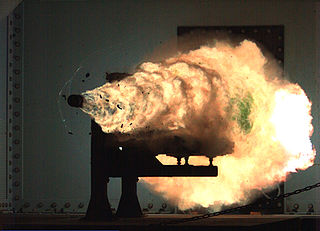
A railgun or rail gun is a linear motor device, typically designed as a weapon, that uses electromagnetic force to launch high-velocity projectiles. The projectile normally does not contain explosives, instead relying on the projectile's high kinetic energy to inflict damage. The railgun uses a pair of parallel conductors (rails), along which a sliding armature is accelerated by the electromagnetic effects of a current that flows down one rail, into the armature and then back along the other rail. It is based on principles similar to those of the homopolar motor.
Muzzle velocity is the speed of a projectile with respect to the muzzle at the moment it leaves the end of a gun's barrel. Firearm muzzle velocities range from approximately 120 m/s (390 ft/s) to 370 m/s (1,200 ft/s) in black powder muskets, to more than 1,200 m/s (3,900 ft/s) in modern rifles with high-velocity cartridges such as the .220 Swift and .204 Ruger, all the way to 1,700 m/s (5,600 ft/s) for tank guns firing kinetic energy penetrator ammunition. To simulate orbital debris impacts on spacecraft, NASA launches projectiles through light-gas guns at speeds up to 8,500 m/s (28,000 ft/s). FPS and MPH are the most common American measurements for bullets. Several factors, including the type of firearm, the cartridge, and the barrel length, determine the bullet's muzzle velocity.

A grenade launcher is a weapon that fires a specially designed, large-caliber projectile, often with an explosive, smoke, or gas warhead. Today, the term generally refers to a class of dedicated firearms firing unitary grenade cartridges. The most common type are man-portable, shoulder-fired weapons issued to individuals, although larger crew-served launchers are issued at higher levels of organization by military forces.
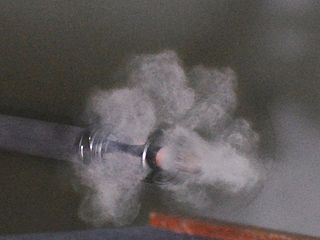
A flash suppressor, also known as a flash guard, flash eliminator, flash hider, or flash cone, is a muzzle device attached to the muzzle of a rifle that reduces its visible signature while firing by cooling or dispersing the burning gases that exit the muzzle, a phenomenon typical of carbine-length weapons. Its primary intent is to reduce the chances that the shooter will be blinded in low-light shooting conditions. Contrary to popular belief, it is only a minor secondary benefit if a flash suppressor reduces the intensity of the flash visible to the enemy.
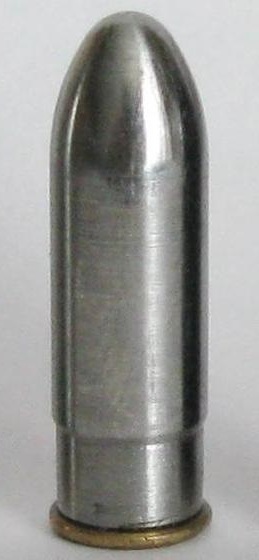
Caseless ammunition (CL), or caseless cartridge, is a configuration of weapon-cartridge that eliminates the cartridge case that typically holds the primer, propellant and projectile together as a unit. Instead, the propellant and primer are fitted to the projectile in another way so that a cartridge case is not needed, for example inside or outside the projectile depending on configuration.

The Mk 19 grenade launcher is an American 40 mm belt-fed automatic grenade launcher that was first developed during the Vietnam War.
Internal ballistics, a subfield of ballistics, is the study of the propulsion of a projectile.

In current usage, a riot gun or less-lethal launcher is a type of firearm used to fire "non-lethal" or "less-lethal" ammunition for the purpose of suppressing riots or apprehending suspects with minimal harm or risk. Less-lethal launchers may be special purpose firearms designed for riot control use, or standard firearms, usually shotguns and grenade launchers, adapted for riot control use with appropriate ammunition. The ammunition is most commonly found in 12 gauge shotguns and 37mm or 40 mm grenade launchers.

The U.S. Army Combat Capabilities Development Command Army Research Laboratory is the U.S. Army's foundational research laboratory. ARL is headquartered at the Adelphi Laboratory Center (ALC) in Adelphi, Maryland. Its largest single site is at Aberdeen Proving Ground, Maryland. Other major ARL locations include Research Triangle Park, North Carolina, White Sands Missile Range, New Mexico, Graces Quarters, Maryland, and NASA's Glenn Research Center, Ohio and Langley Research Center, Virginia. ARL also has regional sites in Playa Vista, California, Chicago, Austin, TX, and Boston.

The United States Armed Forces has created a plethora of different types of 40 mm grenades in both the low-velocity 40×46 mm and high-velocity 40×53 mm calibers which uses what it calls a high-low propulsion system which keeps recoil forces within the boundaries of an infantry weapon. Presented on this page is a basic overview.
The MEI Hellhound 40 mm low-velocity multi-purpose grenade is a fixed-type munition designed to be fired from a 40×46mm grenade launcher such as the M79, M203, M320, or Milkor MK-1. The round consists of a metal projectile body, a fuze, and a cartridge case assembly. Upon impact with the target, the firing pin is driven into the detonator, which in sets off the round, producing a jet which sets off the explosive from the base forward. This results in an armor-piercing jet of molten metal and fragmentation of the projectile body. The MEI Hellhound uses the same high-low propulsion system as other 40 mm grenade launchers.
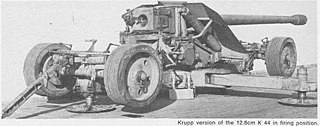
The 12.8 cm Pak 44 is a German anti-tank gun used during World War II. It was designed as a result of experiences on the Eastern front in 1943. The German Army came upon the Soviet 122 mm field guns and issued a requirement for a similar weapon. Development initially concentrated on a field gun known as the Kanone K 44. However, once heavier Soviet tanks such as the IS-2 started to appear, the design requirements were altered to include an anti-armour role.

A combustion light-gas gun (CLGG) is a projectile weapon that utilizes the explosive force of low molecular-weight combustible gases, such as hydrogen mixed with oxygen, as propellant. When the gases are ignited, they burn, expand and propel the projectile out of the barrel with higher efficiency relative to solid propellant and have achieved higher muzzle velocities in experiments. Combustion light-gas gun technology is one of the areas being explored in an attempt to achieve higher velocities from artillery to gain greater range. Conventional guns use solid propellants, usually nitrocellulose-based compounds, to develop the chamber pressures needed to accelerate the projectiles. CLGGs' gaseous propellants are able to increase the propellant's specific impulse. Therefore, hydrogen is typically the first choice; however, other propellants like methane can be used.

A squeeze bore, alternatively taper-bore, cone barrel or conical barrel, is a weapon where the internal barrel diameter progressively decreases towards the muzzle resulting in a reduced final internal diameter. These weapons are used in conjunction with special sub-caliber ammunition where the projectile is fitted with soft-metal flanges which fills out the caliber. As the projectile travels through the squeeze bore the flanges fold inwards, resulting in a reduced caliber round with an increased velocity compared to a traditional full-caliber round.
The Smart Weapon End-to-End Performance Model (SWEEPM) is a modeling software developed by the United States Army Research Laboratory (ARL), designed to measure the overall effectiveness of all types of munitions. SWEEPM was conceived in 2008 and completed in April 2013.
The 75 SA 50 also called 75 Mle 50 or CN 75-50 is a French 75 mm high-velocity rifled gun. Although originally designed for the AMX-13 light tank, the SA 50 has also been used on the EBR wheeled reconnaissance vehicle and foreign medium tanks such as the Israeli upgraded Super Sherman.
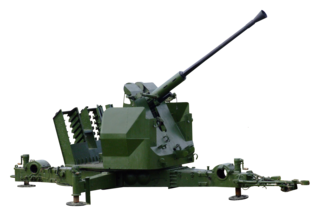
The Bofors 40 mm Automatic Gun L/70,, is a multi-purpose autocannon developed by the Swedish arms manufacturer AB Bofors during the second half of the 1940s as a modern replacement for their extremely successful World War II-era Bofors 40 mm L/60 gun-design. It was initially intended as a dedicated anti-aircraft weapon, being sold as Bofors 40 mm Automatic A.A. Gun L/70, but has since its conception been redeveloped into a dedicated multi-purpose weapon capable of firing both sabot projectiles and programmable ammunition. The Bofors 40 mm L/70 design never achieved the same popularity and historical status as the original L/60 design but has still seen great export and popularity to this day, having been adopted by around 40 different nations and even being accepted as NATO-standard in November 1953. It is still being produced and sold, and several variants exist for both field and naval applications. A notable variant is the Bofors 40/70B "light armored vehicle variant" which is in use on the Swedish Strf 9040 and Korean K21 infantry fighting vehicles.
